Pacific Rim, Week 3: Chinese 2
All your dishes belong to us! Here's the night's dishes ready for service. We prep everything and then cook it all right before service, timing the dishes so they're ready to serve (eat) at the same time. Chef gives us the time he thinks they should be ready, and that's what we aim for. They all sat under the lamps for just about 5 minutes. This week, hooray, no wok fires (that I saw).
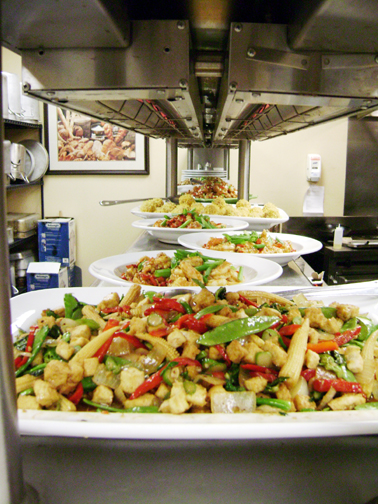
I piled my plate up to ensure I'd have leftovers to bring home. Last week, my classmates ravaged the dishes and looted the leftovers before I could get there from the dishwashing station. Clockwise from 9 o'clock, we've got Oriental Pearl Balls, Szechuan Stir-Fried Shrimp, Fried Tofu and Vegetables in Oyster Sauce, General Tso's Chicken, Egg Roll, and Pork Lo Mein in the middle.
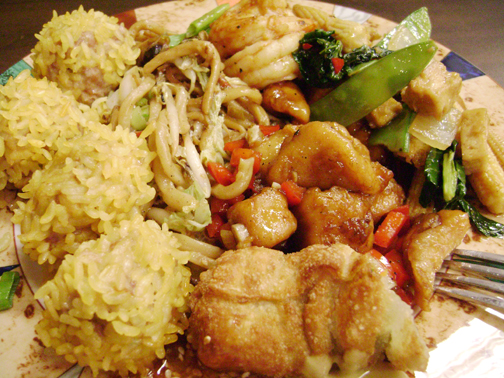
This week's soup was Hot and Sour Soup, Hong Kong Style.
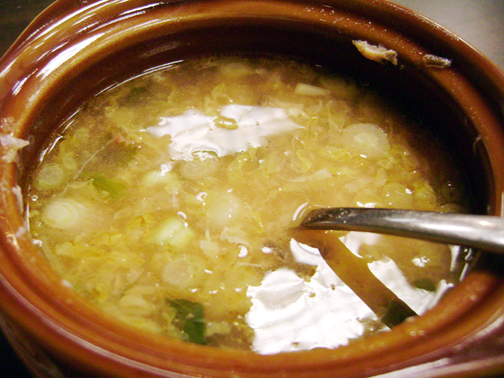
Truth be told, I'm not a big fan of these. The pork filling was fine, but I never like the wrapper's doughy texture. I'm used to the super-thin wrappers, which crisp all the way through, that we use for lumpia.

The Oriental Pearl Balls were basically a pork dumpling filling rolled in short-grain rice and steamed. I liked them, but not everyone could handle the all that pork flavor. I wanted to really pack the rice coating on, but Chef was afraid we didn't have enough to hit all the meatballs. I'd never seen anything like these. At least, not out of a pork dumpling, covered in rice.

I love shrimp. We roasted the shells and made shrimp stock.
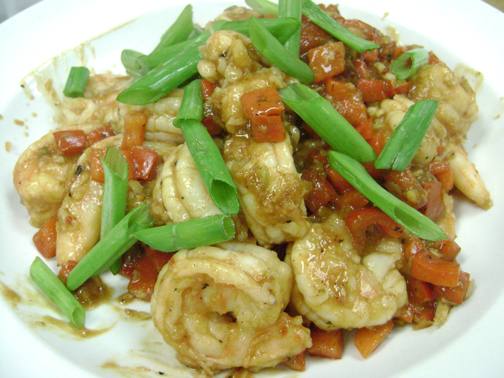
This was good, and a lot of the lo mein haters in class really enjoyed it, but I'm not the hugest lo mein fan. You'd think I would be--I usually love noodles. Fat noodles just always seem too doughy for my preferences. I prefer Hong Kong style noodles.

I really liked this. Frying tofu to firm it up and change its texture is such a great idea. Also: Mmm, snow peas.
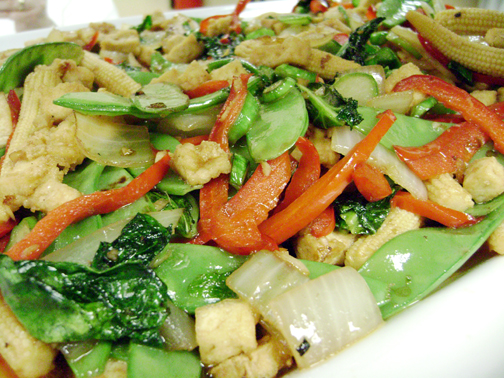
Notes:
According to Chef, "Hong Kong style" means the dish is really colorful, "just like Hong Kong." Sometimes, also according to Chef, this means food coloring is used to bring out those colors. My opinion on it, or at least on this opinion of his, is a whole other post. ;) Chinese food is beautifully colorful, but that's thanks to the quick-cooking technique stir-frying allows. Okay, and also in part to food coloring. Stir-frying not only helps retain vibrant colors, but it helps preserve fresh, clean, strong flavors and crisp, bright textures.
Quick cooking also means having a meticulous mise-en-place. Line up all your ingredients, as well as all your preventative measures. While authentic Chinese food isn't usually as saucy as Americanized Chinese food (as Chef put it, "Americans like their gravy"), it's no good to dry the ingredients out, either. This prevents the flavor in the wok from distributing evenly. It's a good idea to keep some hot stock on hand to add as needed. It's also good to keep your serving plate nearby so you can just scoop the stuff right into it.
Seasoning a wok right before cooking is easy. Just pour some oil into the bottom of the wok, toss in some salt, smear it all over the inside of the wok with a paper towel, and put it on the heat.
If there's stuff stuck to the bottom, cleanup is easy; just add some water and bring it to the boil; any stuff stuck to the bottom should lift right off. Never put a seasoned wok into the dishwasher--you'll wash your seasoning off! For that matter, don't scrub it with an abrasive pad and dish detergent, either.

I piled my plate up to ensure I'd have leftovers to bring home. Last week, my classmates ravaged the dishes and looted the leftovers before I could get there from the dishwashing station. Clockwise from 9 o'clock, we've got Oriental Pearl Balls, Szechuan Stir-Fried Shrimp, Fried Tofu and Vegetables in Oyster Sauce, General Tso's Chicken, Egg Roll, and Pork Lo Mein in the middle.

This week's soup was Hot and Sour Soup, Hong Kong Style.

Truth be told, I'm not a big fan of these. The pork filling was fine, but I never like the wrapper's doughy texture. I'm used to the super-thin wrappers, which crisp all the way through, that we use for lumpia.

The Oriental Pearl Balls were basically a pork dumpling filling rolled in short-grain rice and steamed. I liked them, but not everyone could handle the all that pork flavor. I wanted to really pack the rice coating on, but Chef was afraid we didn't have enough to hit all the meatballs. I'd never seen anything like these. At least, not out of a pork dumpling, covered in rice.

I love shrimp. We roasted the shells and made shrimp stock.

This was good, and a lot of the lo mein haters in class really enjoyed it, but I'm not the hugest lo mein fan. You'd think I would be--I usually love noodles. Fat noodles just always seem too doughy for my preferences. I prefer Hong Kong style noodles.

I really liked this. Frying tofu to firm it up and change its texture is such a great idea. Also: Mmm, snow peas.

Notes:
According to Chef, "Hong Kong style" means the dish is really colorful, "just like Hong Kong." Sometimes, also according to Chef, this means food coloring is used to bring out those colors. My opinion on it, or at least on this opinion of his, is a whole other post. ;) Chinese food is beautifully colorful, but that's thanks to the quick-cooking technique stir-frying allows. Okay, and also in part to food coloring. Stir-frying not only helps retain vibrant colors, but it helps preserve fresh, clean, strong flavors and crisp, bright textures.
Quick cooking also means having a meticulous mise-en-place. Line up all your ingredients, as well as all your preventative measures. While authentic Chinese food isn't usually as saucy as Americanized Chinese food (as Chef put it, "Americans like their gravy"), it's no good to dry the ingredients out, either. This prevents the flavor in the wok from distributing evenly. It's a good idea to keep some hot stock on hand to add as needed. It's also good to keep your serving plate nearby so you can just scoop the stuff right into it.
Seasoning a wok right before cooking is easy. Just pour some oil into the bottom of the wok, toss in some salt, smear it all over the inside of the wok with a paper towel, and put it on the heat.
If there's stuff stuck to the bottom, cleanup is easy; just add some water and bring it to the boil; any stuff stuck to the bottom should lift right off. Never put a seasoned wok into the dishwasher--you'll wash your seasoning off! For that matter, don't scrub it with an abrasive pad and dish detergent, either.
Comments
So I have a question. You say that you guys prep and cook everything prior to service; so is nothing cooked fresh to order? Or is Asian style food easy to pre-cook without a loss of flavor or freshness?
As for cooking to order, that's what I meant--we cook everything just before service. But we get our mise en place ready in advance. All that peeling, slicing, some blanching--we get that stuff out of the way, then line the prepped ingredients up at the wok. Just before it's time for service, we cook it up, plate it, and serve it (or, in our case, get it under the lamps, grab plates, and hit it buffet style). ;D Some dishes like certain soups, rice (as long as there's no chance of it drying out too soon), and meat dishes might handle chafing dishes or even heat lamps ok for a short time, but dishes with fresh produce, pasta that degenerates quickly after cooking (egg rolls, dumplings, won tons--especially in soup, even lo mein), and mixed veg and meat dishes should be cooked to order and go out ASAP.
Thanks for clearing that detail up about the cooking before service. I'm ashamed to say that the only exposure I have to these terms are with Hell's Kitchen. I thought "service" referred to the entire night not each individual dish.